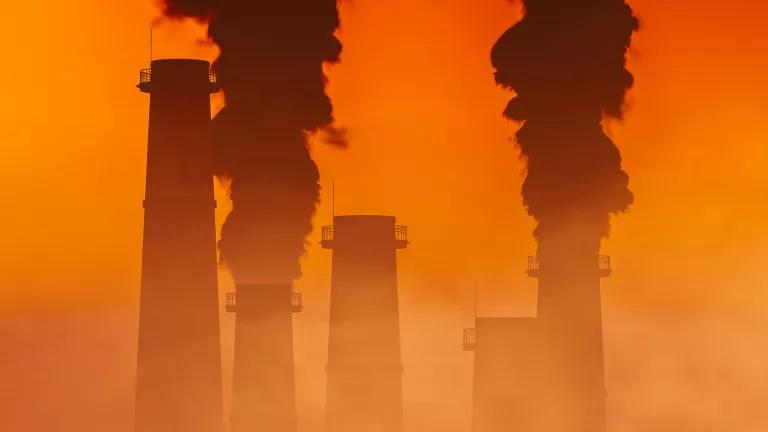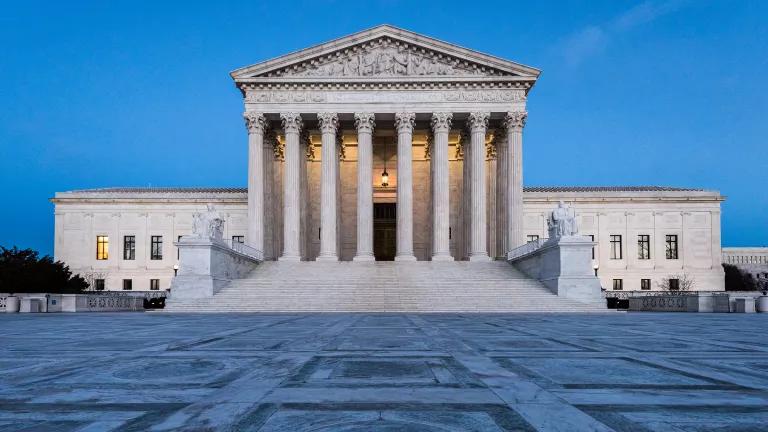EPA Must Act to Limit Deadly Soot Air Pollution
EPA must take action to ensure that clean and healthy air is a reality for all.

Stocksy
Soot air pollution, also known as fine particulate matter, is deadly. It’s a public health menace that contributes to millions of early deaths worldwide each year from heart disease, lung ailments, and cancer. In the United States, millions of people are breathing in polluted air day after day, and it’s imposing huge costs on our society in terms of deaths, illnesses, and reduced worker productivity.
The Clean Air Act sets out legal limits for soot air pollution (and other major air pollutants) that are revisited by the U.S. Environmental Protection Agency (EPA) every five years. As we learn more about the impacts of air pollution on our health, EPA can use that understanding to drive progress to clean up air pollution across the country. The major economic benefits of the Clean Air Act, including those for public health, are estimated to outweigh compliance costs by a factor of more than 30 to 1.
Soot pollution limits stalled since 2012
The annual and daily limits for soot air pollution have not been strengthened since 2012. In the meantime, dozens of large, robust, and peer-reviewed epidemiology studies have been published that make one thing clear: Our current limits are not safe enough. That scientific consensus was confirmed by EPA in 2019 in its Integrated Science Assessment, which implicated soot air pollution in a whole host of dangerous health problems, including respiratory issues, cardiovascular problems, and nervous system effects.
During the Trump administration, progress on cleaning up America’s air stalled. Despite overwhelming evidence that the 2012 soot limits were not adequately protective of public health, the Trump EPA left those limits in place in a rushed December 2020 decision. Because that action would have allowed for dangerous soot exposures to fester for another five years before any new look at the science, NRDC took action and filed a lawsuit against EPA on the last day of the Trump administration, demanding that the agency reconsider its flawed decision. In June 2021, the Biden EPA announced its plan to reopen the decision, setting the stage for this year’s proposal.
EPA’s proposal would still allow dangerous pollution exposures nationwide
In January, EPA proposed a moderate tightening of the annual limit of soot air pollution from 12 to a range of 9–10 µg/m3 (micrograms per cubic meter of air)—but its proposal didn’t go as far as EPA’s Clean Air Scientific Advisory Committee (CASAC) recommendation (down to 8 µg/m3). The agency’s analysis indicated that lowering the standard from 12 to 9 µg/m3 would result in 4,200 fewer deaths each year from soot air pollution, while lowering it only to 10 would result in about 1,900 fewer annual deaths.
The recent proposal also took comments on an even stronger tightening of the limit to the level recommended by CASAC, and EPA’s own math indicates that an annual standard of 8 µg/m3 would result in 9,200 fewer deaths each year—more than doubling the benefits of a weaker limit. Since that proposal was published and a 90-day comment period kicked off in January, NRDC and partners have been working hard to make the case for soot limits that will advance public health and equity across the country. We just delivered our extensive technical comments to EPA that push for the agency to go beyond its proposal, because doing so is what the science supports and what the law requires.
While the difference between 12 and 8 µg/m3 doesn’t sound like much, the differences for human health between these two levels is stark. For example, an NRDC analysis published in January shows that lowering the annual soot limits to that level would protect an additional 57 million people from contaminated air; a weaker limit would only shield an additional 6.5 million people.
Importantly, many new scientific studies have documented significant human health harms at exposure levels below the current legal limits—with key benefits for vulnerable people, including older populations, at 8 µg/m3. For example, a study of soot exposures for Medicare beneficiaries found that health dangers for the same dose of exposure were even more intense at levels below the current legal limits. Additional research confirms the basic finding that the current soot limits should be strengthened to reduce health risks. Specifically, daily and annual soot limits should be set at levels that are protective of the populations who are most vulnerable to pollution. For soot, EPA has already acknowledged that the most at-risk populations today are Black and Hispanic populations.
Separately, EPA proposed leaving the maximum daily limits for soot unchanged. The agency argues that a stronger annual limit on soot makes any tightening of the daily standard unnecessary—but we disagree, because our analysis shows that areas of the country could meet the new annual standard while experiencing unhealthy soot pollution spikes on a 24-hour basis far above the current daily cap of 35 µg/m3.

Activists gather in front of the Supreme Court on February 28th, 2022 to show support for protecting the Clean Air Act.
Leigh Vogel/Getty Images for NRDC
Stronger limits help to reduce longstanding health disparities
While national air pollution reductions delivered by the Clean Air Act have been substantial, the benefits of this landmark law have not accrued equitably. Scientific studies show that marginalized populations, including Black Americans and low-income communities, continue to be exposed to disproportionately high burdens of soot air pollution. Those exposures contribute to health disparities that burden these populations with higher rates of life-threatening chronic diseases, including heart disease, chronic obstructive pulmonary disease, and asthma.
Strikingly, a 2020 study published in the leading journal Science showed that the census tracts with the most soot air pollution 1981 remained the most polluted in 2016. It’s true that the average soot pollution exposure across the country fell during those 35 years—but that generalized improvement obscures disparities in exposures that continue to harm marginalized populations the most. Another analysis found that a soot limit of 8 µg/m3 would go further to reduce inequities in the health burden of air pollution than a standard of 10 µg/m3, particularly between Black and white populations. In that study, people experiencing poverty would see 30 percent higher benefits in terms of reduced mortality compared to higher-income communities.
The scientific evidence supporting strong action from EPA continues to pile up. Just this week, a new study of more than 73 million people published in the New England Journal of Medicine reported that an annual standard no higher than 8 μg/m3 is necessary to reduce disparities that disproportionately harm marginalized subpopulations, including black Americans and low-income populations.
EPA must finalize strong soot pollution limits
There is overwhelming evidence that the national soot limits must be strengthened to be adequately protective of public health. That’s why this week, NRDC is joining with partners to submit comments to EPA that explain why it should finalize strong soot limits that will deliver cleaner and healthier air to all. Our extensive comments, spanning 177 pages, highlight all of the scientific research that justifies EPA to lower the legal annual limit for soot to no higher than 8 µg/m3 and the daily limit to no higher than 25 µg/m3.
After an era of reckless decisions that denied hard facts about air pollution–related health risks, we need to get back on course. Now is the time for EPA to follow the evidence, listen to its own scientific experts, and follow the law. It must take action to ensure that clean and healthy air is a reality for all.





